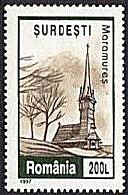


More than 300 bird species live in the delta, including the White and Dalmatian Pelicans.
The listing in 1993 for Biertran and its fortified church was expanded to include six other Transylvanian villages in 1999: Calnic, Valea Viilor, Saschiz, Darjiu, Viscri, and Prejmer.
Built in 1693, Hurez Monastery is the largest of Wallachia's Brincoveanu complexes. It is the site of the school which established the distinctively Romanian style developed by Constantine Brincoveanu. Interior frescoes in the church have been tarnished by the smoke from fires lit by Turkish slaves who camped there.

Founded by German craftsmen and merchants known as the Saxons of Transylvania, Sighisoara is an example of a fortified medieval town which played an important strategic and commercial role on the fringes of central Europe for several centuries.
The Geto-Dacian branch of the Thracians are mentioned for the first time by Herodotus in connection with the 514 BC expedition of the Persian king Darius. The center of their power was Transylvania, where, in the Orastie Mountains, still exist archaeological traces of their civilization. One of their most important leaders was king Burebista who controlled a large territory. He was assassinated in 44 BC, almost at the same time as Julius Ceasar, just before their confrontation.
The six defensive works included in the Unesco property are:
Additional links

Includes:
For more links see Joint listing with Slovakia.
Joint listing with Albania, Austria, Belgium, Bosnia and Herzegovina, Bulgaria, Croatia, Czechia, France, Germany, Italy, Macedonia, Poland, Romania, Slovakia, Slovenia, Spain, Switzerland, and Ukraine. These are the largest remaining virgin forests of the European beech (Fagus sylvatica). They also hold the largest and tallest beech specimens in the world. This site originally consisted of ten separate components along an 185 km axis from the Rakhiv Mountains and the Chornohirskyi Range in the Ukraine, west along the Polonynian Ridge, to the Bukovske Vrchy and Vihorlat Mountains in Slovakia. The listing was extended in 2011 to include 5 Ancient Beech forests in Germany, further extended in 2017 to include more forests in 10 countries, and further extended in 2021.
Underground Roman gold mining complex known at the time of inscription as Alburnus Maior.
The abstract sculpute was created in 1937-38 by Constantin Brancusi to commemorate those who died defending the city during WWI.
Last updated: July 27, 2024